Tropical Forest Microclimatic Changes: Hurricane, Drought, and 15–20 Year Climate Trend Effects on Elevational Gradient Temperature and Moisture
Abstract
1. Introduction
2. Materials and Methods
2.1. Study Area
2.2. Methods
2.2.1. Data Collection
| Elev (m) | Map ID | Site Name | Vegetation a | Open Air Temp DV b % Missing c,d | Air Temp DV b % Missing c,d | Soil Temp DV b % Missing c,d | Precip DV b from Obs with Interval ≥ 3 wks d | Soil Moist DV b % Missing c,d |
|---|---|---|---|---|---|---|---|---|
| 0 | 6 | Palmas del Mar | freshw riparian | 20 | 24 | 21 | 10 | - |
| 2 | 7 | Sabana Seca | mangrove | 19 | 33 | 41 | 17 | - |
| freshw riparian | 34 | 44 | - | |||||
| 2 | 5 | Humacao | freshw riparian | 12 | 54 | 59 | 11 | - |
| 4 | 21 | Ceiba Wet | mangrove | - | 20 | 28 | - | - |
| 4 | 2 | Las Cabezas Wet | mangrove | 14 | 21 | 25 | 18 | - |
| 11 | 3 | Ceiba Dry North | semi-evg dry | 16 | 11 | 17 | 15 | 26 |
| 12 | 4 | Ceiba Dry South | semi-evg dry | 14 | 19 | 21 | 14 | - |
| 13 | 8 | Ford | semi-evg moist | 15 | 21 | 23 | 13 | - |
| 34 | 10 | Jardin Botánico | semi-evg moist | 12 | 23 | 19 | 11 | - |
| 35 | 1 | Las Cabezas Dry | semi-evg dry | 12 | 31 | 21 | 19 | - |
| 95 | 9 | Saint Just | semi-evg moist | 18 | 21 | 24 | 20 | - |
| 265 | 11 | Sabana 4/Bisley | tabonuco evg | 12 | 20 | 24 | 20 | - |
| 401 | 12 | El Verde | tabonuco evg | 12 | 17 | 27 | 12 | 28 |
| 520 | 13 | Rio Grande | tabonuco evg | 13 | 18 | 26 | 10 | - |
| 644 | 14 | UPR Nido | palm brake | 13 | 18 | 17 | 32 | - |
| 765 | 16 | Pico del Este Lower | colorado evg | 15 | 19 | 18 | 16 | - |
| 784 | 17 | El Toro | colorado evg | 13 | 18 | 23 | 11 | 27 |
| 801 | 16 | 16 | - | |||||
| 843 | 22 | Pico del Este Mid | palm brake | - | 17 | 24 | - | - |
| 912 | 15 | Mount Britton | palm brake | 20 | 23 | 23 | 15 | - |
| 991 | 19 | Pico del Oeste | cloud elfin | 14 | 16 | 14 | 23 | - |
| 996 | 18 | Pico del Este Upper | cloud elfin | 14 | 18 | 18 | 15 | - |
| 1045 | 20 | El Yunque | cloud elfin | 15 | 23 | 19 | 18 | 37 |
2.2.2. Statistical Analysis
3. Results
3.1. Temperature Results
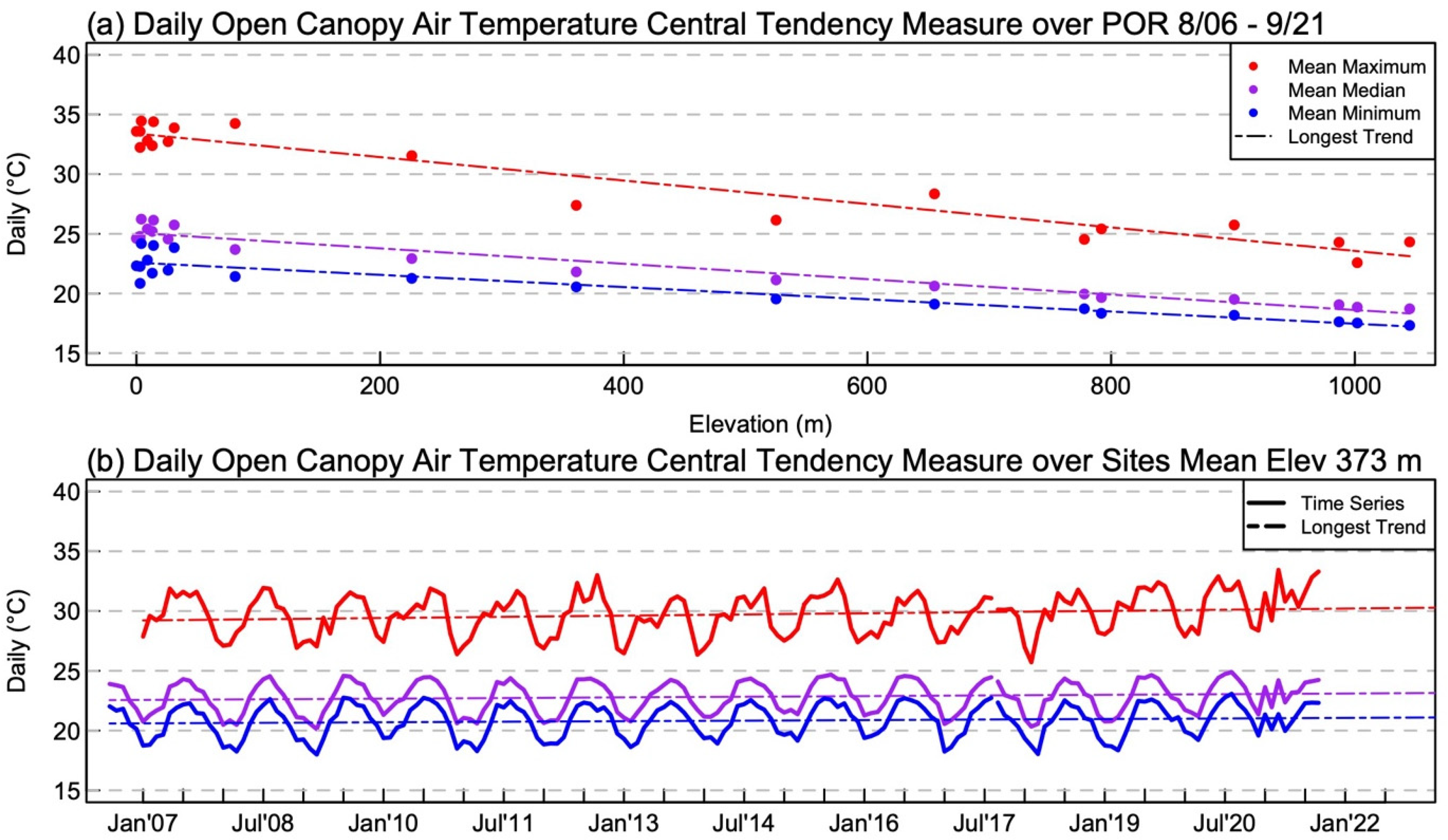
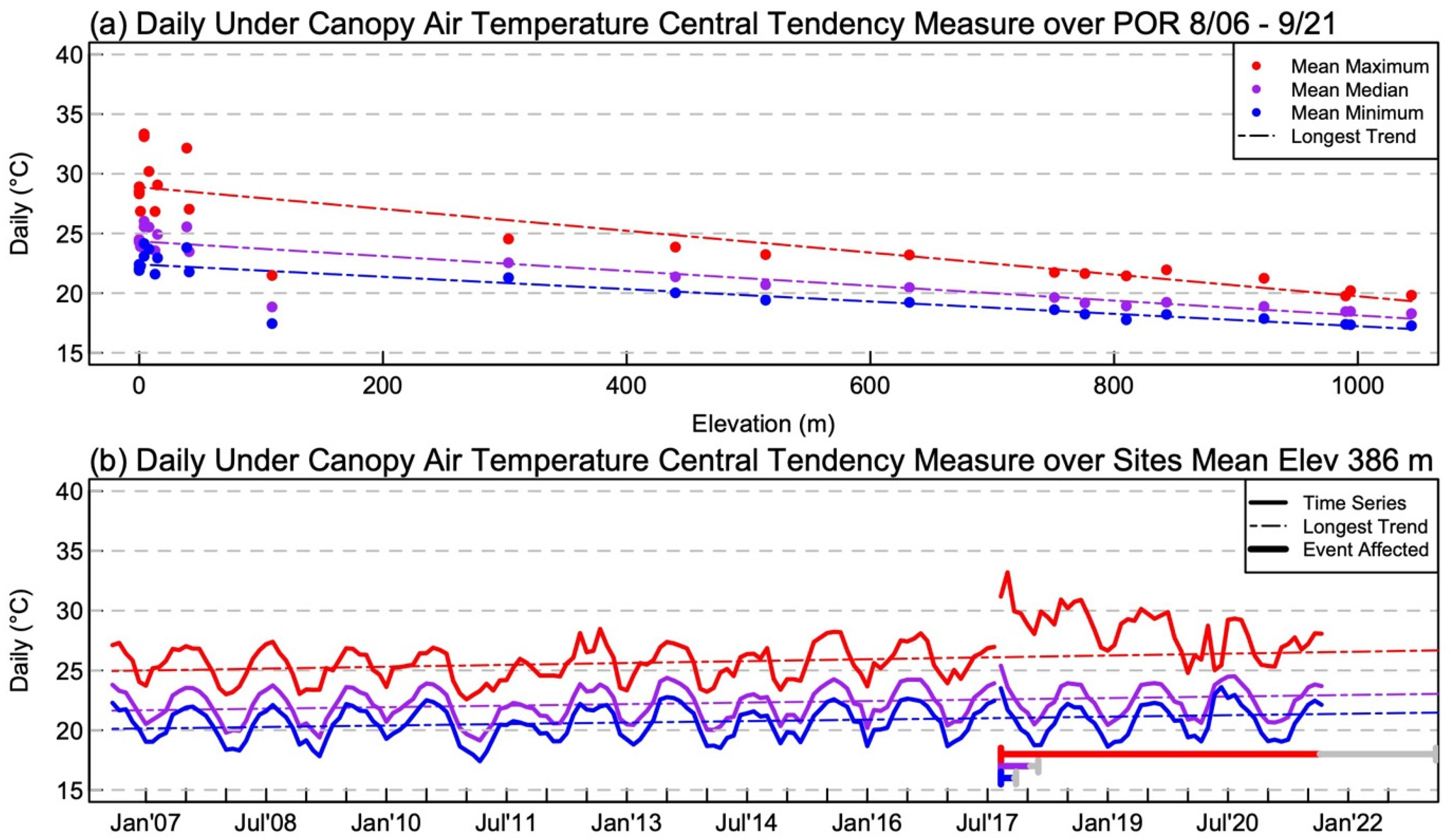
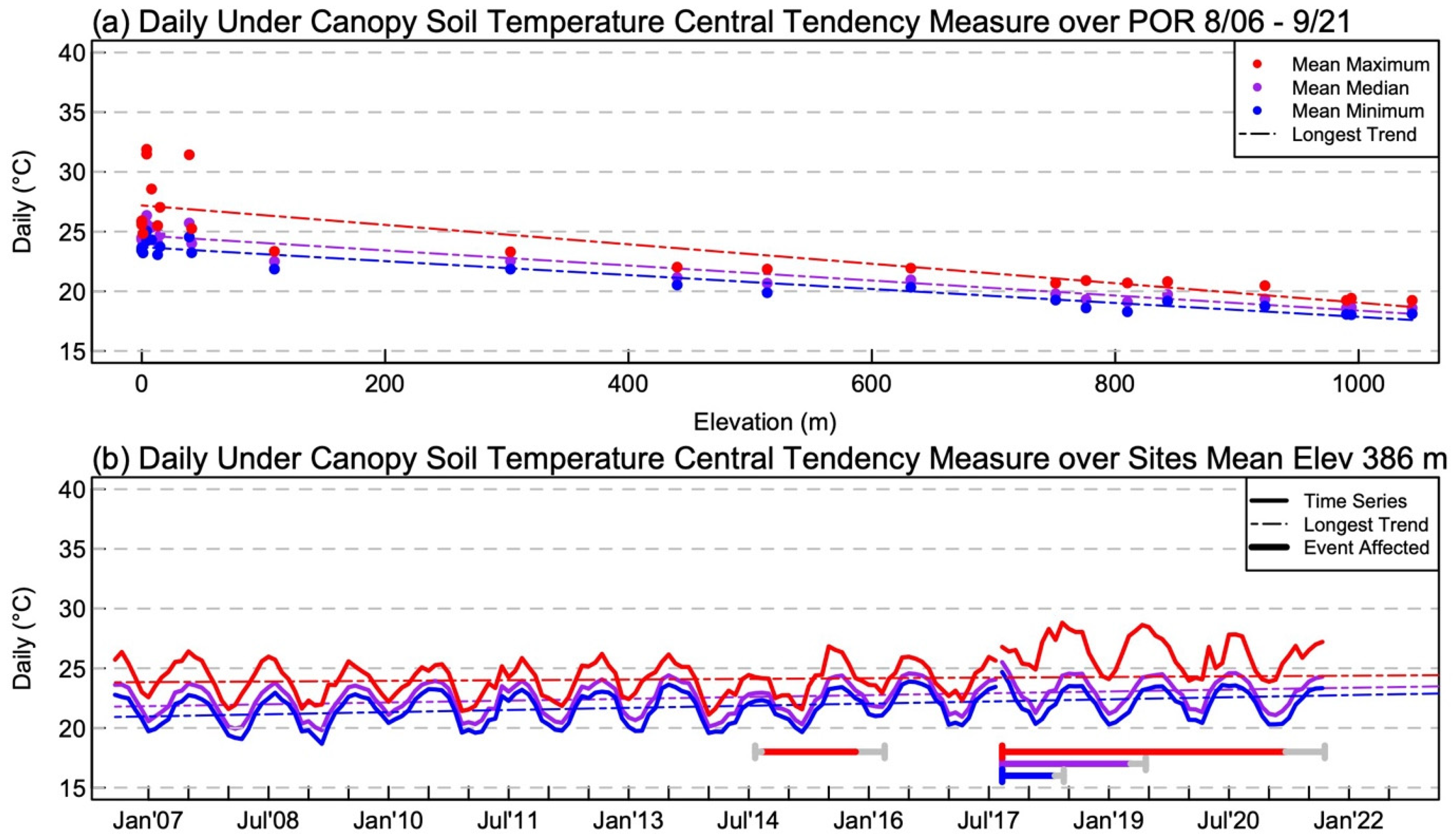
| Type of Statistic a | Open Air Temp Daily Max | Canopy Air Temp Daily Max | Canopy Soil Temp Daily Max | Open Air Temp Daily Median | Canopy Air Temp Daily Median | Canopy Soil Temp Daily Median | Open Air Temp Daily Min | Canopy Air Temp Daily Min | Canopy Soil Temp Daily Min |
|---|---|---|---|---|---|---|---|---|---|
| Annual averages (°C) | −9.83x + 33.39 | −9.15x + 28.88 | −8.15x + 27.19 | −6.45x + 25.07 | −6.21x + 24.33 | −6.29x + 24.68 | −5.12x + 22.59 | −5.18x + 22.41 | −5.84x + 23.69 |
| Trend b before drought (°C/yr) | −0.12 | 0.05 | −0.02 | 0.03 | 0.06 | 0.07 | 0.03 | 0.07 | 0.09 |
| Trend b before hurricanes (°C/yr) | −0.01 | 0.10 | 0.10x + 0.00 | 0.05 | 0.08 | 0.10 | 0.05 | 0.08 | 0.12 |
| Trend b whole record (°C/yr) | 0.13x + 0.02 | 0.03 | 0.03 | ||||||
| Drought peak effect (°C) | −2.31x + 4.40 | ||||||||
| Drought effect length (yr) | 1.64 | ||||||||
| Hurricane peak effect (°C) | −2.97x + 6.08 | 2.91 | 0.77 | 0.69 | −0.56x + 0.84 | 0.43 | |||
| Hurricane effect length (yr) | 4.73 | 3.90x + 3.20 | 0.42 | 1.70 | 0.18 | 0.71 |
3.2. Precipitation and Soil Moisture Results
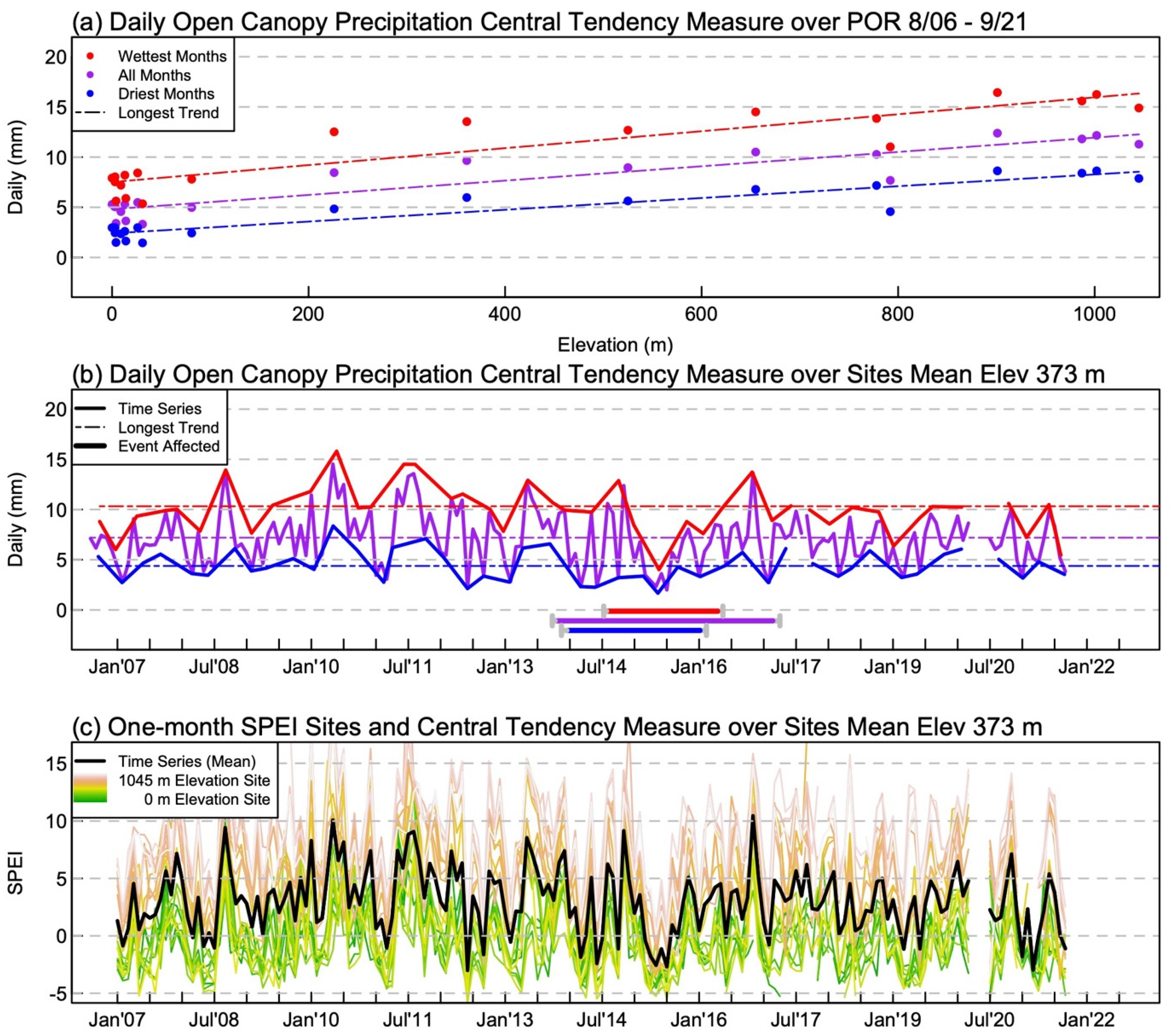

| Type of Statistic a | Open Precip Wettest Months | Canopy Soil Moist Wettest Months | Open Precip All Months | Canopy Soil Moist All Months | Open Precip Driest Months | Canopy Soil Moist Driest Months |
|---|---|---|---|---|---|---|
| Annual averages (water b) | 8.62x + 7.41 | 0.50 | 7.27x + 4.86 | 0.45 | 6.16x + 2.58 | 0.40 |
| Trend c before drought (water b/yr) | 0.00 | 0.01 | 0.06 | 0.00 | 0.00 | 0.01 |
| Trend c before hurricanes (water b/yr) | −0.01 | 0.00 | −0.01 | 0.00 | −0.01 | 0.00 |
| Trend c whole record (water b/yr) | −0.04 | 0.00 | 0.00 | |||
| Drought peak effect (water b) | −4.53x − 6.14 | 0.24x − 0.35 | −5.82x − 5.84 | −0.22 | −4.53x − 1.82 | −0.16 |
| Drought effect length (yr) | 1.78 | 2.47 | 3.45 | 3.25 | 2.15 | 0.56x + 1.84 |
| Hurricane peak effect (water b) | −0.14x + 0.15 | −0.18x + 0.21 | 0.16 | |||
| Hurricane effect length (yr) | 0.33 | 3.89 | 1.33 |
4. Discussion
5. Conclusions
Author Contributions
Funding
Data Availability Statement
Acknowledgments
Conflicts of Interest
References
- Shiels, A.B.; González, G.; Lodge, D.J.; Willig, M.R.; Zimmerman, J.K. Cascading Effects of Canopy Opening and Debris Deposition from a Large-Scale Hurricane Experiment in a Tropical Rain Forest. Bioscience 2015, 65, 871–881. [Google Scholar] [CrossRef]
- Van Beusekom, A.E.; González, G.; Stankavich, S.; Zimmerman, J.K.; Ramírez, A. Understanding Tropical Forest Abiotic Response to Hurricanes Using Experimental Manipulations, Field Observations, and Satellite Data. Biogeosciences 2020, 17, 3149–3163. [Google Scholar] [CrossRef]
- Burslem, D.F.R.P.; Whitmore, T.C.; Brown, G.C. Short-Term Effects of Cyclone Impact and Long-Term Recovery of Tropical Rain Forest on Kolombangara, Solomon Islands. J. Ecol. 2000, 88, 1063–1078. [Google Scholar] [CrossRef]
- O’Connell, C.S.; Ruan, L.; Silver, W.L. Drought Drives Rapid Shifts in Tropical Rainforest Soil Biogeochemistry and Greenhouse Gas Emissions. Nat. Commun. 2018, 9, 1348. [Google Scholar] [CrossRef]
- Cupples, A.M. Principles and Applications of Soil Microbiology. J. Environ. Qual. 2005, 34, 731. [Google Scholar] [CrossRef]
- Enquist, C.A.F. Predicted Regional Impacts of Climate Change on the Geographical Distribution and Diversity of Tropical Forests in Costa Rica. J. Biogeogr. 2002, 29, 519–534. [Google Scholar] [CrossRef]
- Hilbert, D.W.; Ostendorf, B.; Hopkins, M.S. Sensitivity of Tropical Forests to Climate Change in the Humid Tropics of North Queensland. Austral Ecol. 2001, 26, 590–603. [Google Scholar] [CrossRef]
- Wang, H.; Hall, C.A.S.; Scatena, F.N.; Fetcher, N.; Wu, W. Modeling the Spatial and Temporal Variability in Climate and Primary Productivity across the Luquillo Mountains, Puerto Rico. For. Ecol. Manag. 2003, 179, 69–94. [Google Scholar] [CrossRef]
- Zimmerman, J.K.; Wood, T.E.; González, G.; Ramirez, A.; Silver, W.L.; Uriarte, M.; Willig, M.R.; Waide, R.B.; Lugo, A.E. Disturbance and Resilience in the Luquillo Experimental Forest. Biol. Conserv. 2021, 253, 108891. [Google Scholar] [CrossRef]
- Ali, A.; Lin, S.-L.; He, J.-K.; Kong, F.-M.; Yu, J.-H.; Jiang, H.-S. Climatic Water Availability Is the Main Limiting Factor of Biotic Attributes across Large-Scale Elevational Gradients in Tropical Forests. Sci. Total Environ. 2019, 647, 1211–1221. [Google Scholar] [CrossRef]
- Lugo, A.E. Visible and Invisible Effects of Hurricanes on Forest Ecosystems: An International Review. Austral Ecol. 2008, 33, 368–398. [Google Scholar] [CrossRef]
- Wunderle, J.M., Jr.; Lodge, D.J.; Waide, R.B. Short-Term Effects of Hurricane Gilbert on Terrestrial Bird Populations on Jamaica. Auk 1992, 109, 148–166. [Google Scholar] [CrossRef]
- Beard, K.H.; Vogt, K.A.; Vogt, D.J.; Scatena, F.N.; Covich, A.P.; Sigurdardottir, R.; Siccama, T.G.; Crowl, T.A. Structural and Functional Responses of a Subtropical Forest to 10 Years of Hurricanes and Droughts. Ecol. Monogr. 2005, 75, 345–361. [Google Scholar] [CrossRef]
- Corlett, R.T. Impacts of Warming on Tropical Lowland Rainforests. Trends Ecol. Evol. 2011, 26, 606–613. [Google Scholar] [CrossRef]
- Cantrell, S.A.; Lodge, D.J.; Cruz, C.A.; García, L.M.; Pérez-Jiménez, J.R.; Molina, M. Differential Abundance of Microbial Functional Groups along the Elevation Gradient from the Coast to the Luquillo Mountains. Ecol. Bull. 2013, 54, 87–100. [Google Scholar]
- Richardson, B.A.; Richardson, M.J. Litter-Based Invertebrate Communities in Forest Floor and Bromeliad Microcosms along an Elevational Gradient in Puerto Rico. Ecol. Bull. 2013, 54, 101–115. [Google Scholar]
- Willig, M.R.; Presley, S.J.; Bloch, C.P.; Alvarez, J. Population, Community, and Metacommunity Dynamics of Terrestrial Gastropods in the Luquillo Mountains: A Gradient Perspective. Ecol. Bull. 2013, 54, 117–140. [Google Scholar]
- Campos-Cerqueira, M.; Aide, T.M. Impacts of a Drought and Hurricane on Tropical Bird and Frog Distributions. Ecosphere 2021, 12, e03352. [Google Scholar] [CrossRef]
- Ping, C.-L.; Michaelson, G.J.; Stiles, C.A.; González, G. Soil Characteristics, Carbon Stores, and Nutrient Distribution in Eight Forest Types along an Elevation Gradient, Eastern Puerto Rico. Ecol. Bull. 2013, 54, 67–86. [Google Scholar]
- Silver, W.L.; Liptzin, D.; Almaraz, M. Soil Redox Dynamics and Biogeochemistry along a Tropical Elevation Gradient. Ecol. Bull. 2013, 54, 195–209. [Google Scholar]
- Chen, D.; Yu, M.; González, G.; Zou, X.; Gao, Q. Climate Impacts on Soil Carbon Processes along an Elevation Gradient in the Tropical Luquillo Experimental Forest. Forests 2017, 8, 90. [Google Scholar] [CrossRef]
- González, G.; Luce, M.M. Woody Debris Characterization along an Elevation Gradient in Northeastern Puerto Rico. Ecol. Bull. 2013, 54, 181–193. [Google Scholar]
- Harris, N.L.; Medina, E. Changes in Leaf Properties across an Elevation Gradient in the Luquillo Mountains, Puerto Rico. Ecol. Bull. 2013, 54, 169–179. [Google Scholar]
- Weaver, P.L.; Gould, W.A. Forest Vegetation along Environmental Gradients in Northeastern Puerto Rico. Ecol. Bull. 2013, 54, 43–65. [Google Scholar]
- Yu, M.; Gao, Q. Topography, Drainage Capability, and Legacy of Drought Differentiate Tropical Ecosystem Response to and Recovery from Major Hurricanes. Environ. Res. Lett. 2020, 15, 104046. [Google Scholar] [CrossRef]
- Leitold, V.; Morton, D.C.; Martinuzzi, S.; Paynter, I.; Uriarte, M.; Keller, M.; Ferraz, A.; Cook, B.D.; Corp, L.A.; González, G. Tracking the Rates and Mechanisms of Canopy Damage and Recovery Following Hurricane Maria Using Multitemporal Lidar Data. Ecosystems 2021, 25, 892–910. [Google Scholar] [CrossRef]
- Schwartz, N.B.; Budsock, A.M.; Uriarte, M. Fragmentation, Forest Structure, and Topography Modulate Impacts of Drought in a Tropical Forest Landscape. Ecology 2019, 100, e02677. [Google Scholar] [CrossRef]
- Schwartz, N.B.; Feng, X.; Muscarella, R.; Swenson, N.G.; Umaña, M.N.; Zimmerman, J.K.; Uriarte, M. Topography and Traits Modulate Tree Performance and Drought Response in a Tropical Forest. Front. For. Glob. Chang. 2020, 3, 596256. [Google Scholar] [CrossRef]
- Smith-Martin, C.M.; Muscarella, R.; Ankori-Karlinsky, R.; Delzon, S.; Farrar, S.L.; Salva-Sauri, M.; Thompson, J.; Zimmerman, J.K.; Uriarte, M. Hydraulic Traits Are Not Robust Predictors of Tree Species Stem Growth during a Severe Drought in a Wet Tropical Forest. Funct. Ecol. 2022. [Google Scholar] [CrossRef]
- Pepin, N.C.; Arnone, E.; Gobiet, A.; Haslinger, K.; Kotlarski, S.; Notarnicola, C.; Palazzi, E.; Seibert, P.; Serafin, S.; Schöner, W.; et al. Climate Changes and Their Elevational Patterns in the Mountains of the World. Rev. Geophys. 2022, 60, e2020RG000730. [Google Scholar] [CrossRef]
- Waide, R.B.; Comarazamy, D.E.; González, J.E.; Hall, C.A.S.; Lugo, A.E.; Luvall, J.C.; Murphy, D.J.; Ortiz-Zayas, J.R.; Ramírez-Beltran, N.D.; Scatena, F.N.; et al. Climate Variability at Multiple Spatial and Temporal Scales in the Luquillo Mountains, Puerto Rico. Ecol. Bull. 2013, 54, 21–41. [Google Scholar]
- González, G.; Willig, M.R.; Waide, R.B. Ecological Gradient Analyses in a Tropical Landscape: Multiples Perspectives and Emerging Themes. Ecol. Bull. 2013, 54, 13–20. [Google Scholar]
- Gould, W.A.; González, G.; Carrero Rivera, G. Structure and Composition of Vegetation along an Elevational Gradient in Puerto Rico. J. Veg. Sci. 2006, 17, 653–664. [Google Scholar] [CrossRef]
- Van Beusekom, A.E.; González, G.; Rivera, M.M. Short-Term Precipitation and Temperature Trends along an Elevation Gradient in Northeastern Puerto Rico. Earth Interact. 2015, 19, 1–33. [Google Scholar] [CrossRef]
- Van Beusekom, A.E.; González, G.; Scholl, M.A. Analyzing Cloud Base at Local and Regional Scales to Understand Tropical Montane Cloud Forest Vulnerability to Climate Change. Atmos. Chem. Phys. 2017, 17, 7245–7259. [Google Scholar] [CrossRef]
- Malkus, J.S. The Effects of a Large Island upon the Trade-Wind Air Stream. Q. J. R. Meteorol. Soc. 1955, 81, 538–550. [Google Scholar] [CrossRef]
- Odum, H.T.; Pigeon, R.F. A Tropical Rain Forest: A Study of Irradiation and Ecology at El Verde, Puerto Rico; US Atomic Energy Commission, Division of Technical Information: Washington, DC, USA, 1970. [Google Scholar]
- Giannini, A.; Kushnir, Y.; Cane, M.A. Interannual Variability of Caribbean Rainfall, ENSO, and the Atlantic Ocean. J. Clim. 2000, 13, 297–311. [Google Scholar] [CrossRef]
- Taylor, M.A.; Whyte, F.S.; Stephenson, T.S.; Campbell, J.D. Why Dry? Investigating the Future Evolution of the Caribbean Low Level Jet to Explain Projected Caribbean Drying. Int. J. Climatol. 2013, 33, 784–792. [Google Scholar] [CrossRef]
- Holdridge, L.R.; Grenke, W.C. Forest Environments in Tropical Life Zones: A Pilot Study; Pergamon Press: Oxford, UK, 1971. [Google Scholar]
- Ewel, J.J.; Whitmore, J.L. The Ecological Life Zones of Puerto Rico and the US Virgin Islands; Research Paper ITF-018; USDA Forest Service, Institute of Tropical Forestry: Washington, DC, USA, 1973; p. 18. [Google Scholar]
- Velazquez-Lozada, A.; Gonzalez, J.E.; Winter, A. Urban Heat Island Effect Analysis for San Juan, Puerto Rico. Atmos. Environ. 2006, 40, 1731–1741. [Google Scholar] [CrossRef]
- Medina, E.; González, G.; Rivera, M.M. Spatial and Temporal Heterogeneity of Rainfall Inorganic Ion Composition in Northeastern Puerto Rico. Ecol. Bull. 2013, 54, 157–167. [Google Scholar]
- Schellekens, J.; Scatena, F.N.; Bruijnzeel, L.A.; Wickel, A.J. Modelling Rainfall Interception by a Lowland Tropical Rain Forest in Northeastern Puerto Rico. J. Hydrol. 1999, 225, 168–184. [Google Scholar] [CrossRef]
- Baldocchi, D.; Falge, E.; Wilson, K. A Spectral Analysis of Biosphere–Atmosphere Trace Gas Flux Densities and Meteorological Variables across Hour to Multi-Year Time Scales. Agric. For. Meteorol. 2001, 107, 1–27. [Google Scholar] [CrossRef]
- Mills, T.C. Spectral Analysis of Time Series: The Periodogram Revisited and Reclaimed. In The Foundations of Modern Time Series Analysis; Springer: Berlin/Heidelberg, Germany, 2011; pp. 357–374. [Google Scholar]
- Pelletier, J.D. Natural Variability of Atmospheric Temperatures and Geomagnetic Intensity over a Wide Range of Time Scales. Proc. Natl. Acad. Sci. USA 2002, 99, 2546–2553. [Google Scholar] [CrossRef] [PubMed]
- Richards, M.T.; Rogers, M.L.; Richards, D.S.P. Long-Term Variability in the Length of the Solar Cycle. Publ. Astron. Soc. Pac. 2009, 121, 797–809. [Google Scholar] [CrossRef]
- Wu, W.; Geller, M.A.; Dickinson, R.E. The Response of Soil Moisture to Long-Term Variability of Precipitation. J. Hydrometeorol. 2002, 3, 604–613. [Google Scholar] [CrossRef]
- Hirsch, R.M.; Slack, J.R. A Nonparametric Trend Test for Seasonal Data with Serial Dependence. Water Resour. Res. 1984, 20, 727–732. [Google Scholar] [CrossRef]
- Hirsch, R.M.; Slack, J.R.; Smith, R.A. Techniques of Trend Analysis for Monthly Water Quality Data. Water Resour. Res. 1982, 18, 107–121. [Google Scholar] [CrossRef]
- Sen, P.K. Estimates of the Regression Coefficient Based on Kendall’s Tau. J. Am. Stat. Assoc. 1968, 63, 1379–1389. [Google Scholar] [CrossRef]
- Thiel, H. A Rank-Invariant Method of Linear and Polynomial Regression Analysis. Indag. Math. 1950, 12, 173–184. [Google Scholar]
- Vicente-Serrano, S.M.; Beguería, S.; López-Moreno, J.I. A Multiscalar Drought Index Sensitive to Global Warming: The Standardized Precipitation Evapotranspiration Index. J. Clim. 2010, 23, 1696–1718. [Google Scholar] [CrossRef]
- Sorí, R.; Méndez-Tejeda, R.; Stojanovic, M.; Fernández-Alvarez, J.C.; Pérez-Alarcón, A.; Nieto, R.; Gimeno, L. Spatio-Temporal Assessment of Meteorological Drought in Puerto Rico between 1950 and 2019. Environ. Sci. Proc. 2021, 8, 40. [Google Scholar] [CrossRef]
- Reed, S.C.; Reibold, R.; Cavaleri, M.A.; Alonso-Rodríguez, A.M.; Berberich, M.E.; Wood, T.E. Chapter Six—Soil Biogeochemical Responses of a Tropical Forest to Warming and Hurricane Disturbance. In Advances in Ecological Research; Tropical Ecosystems in the 21st Century; Dumbrell, A.J., Turner, E.C., Fayle, T.M., Eds.; Academic Press: Cambridge, MA, USA, 2020; Volume 62, pp. 225–252. [Google Scholar]
- Bouskill, N.J.; Wood, T.E.; Baran, R.; Ye, Z.; Bowen, B.P.; Lim, H.; Zhou, J.; Nostrand, J.D.V.; Nico, P.; Northen, T.R.; et al. Belowground Response to Drought in a Tropical Forest Soil. I. Changes in Microbial Functional Potential and Metabolism. Front. Microbiol. 2016, 7, 525. [Google Scholar] [CrossRef] [PubMed]
- Uriarte, M.; Muscarella, R.; Zimmerman, J.K. Environmental Heterogeneity and Biotic Interactions Mediate Climate Impacts on Tropical Forest Regeneration. Glob. Chang. Biol. 2018, 24, e692–e704. [Google Scholar] [CrossRef] [PubMed]
- Song, X.; Li, J.; Zhang, W.; Tang, Y.; Sun, Z.; Cao, M. Variant Responses of Tree Seedling to Seasonal Drought Stress along an Elevational Transect in Tropical Montane Forests. Sci. Rep. 2016, 6, 36438. [Google Scholar] [CrossRef]
- Wood, T.E.; Cavaleri, M.A.; Giardina, C.P.; Khan, S.; Mohan, J.E.; Nottingham, A.T.; Reed, S.C.; Slot, M. Chapter 14—Soil Warming Effects on Tropical Forests with Highly Weathered Soils. In Ecosystem Consequences of Soil Warming; Mohan, J.E., Ed.; Academic Press: Cambridge, MA, USA, 2019; pp. 385–439. ISBN 978-0-12-813493-1. [Google Scholar]
- González, G.; Van Beusekom, A.E.; Rivera, M.M. Northeastern Puerto Rico Open-Canopy and Under-Canopy Temperature and Moisture Data on an Elevational Gradient 2006–2021; Forest Service Research Data Archive: Fort Collins, CO, USA, 2022. [Google Scholar] [CrossRef]
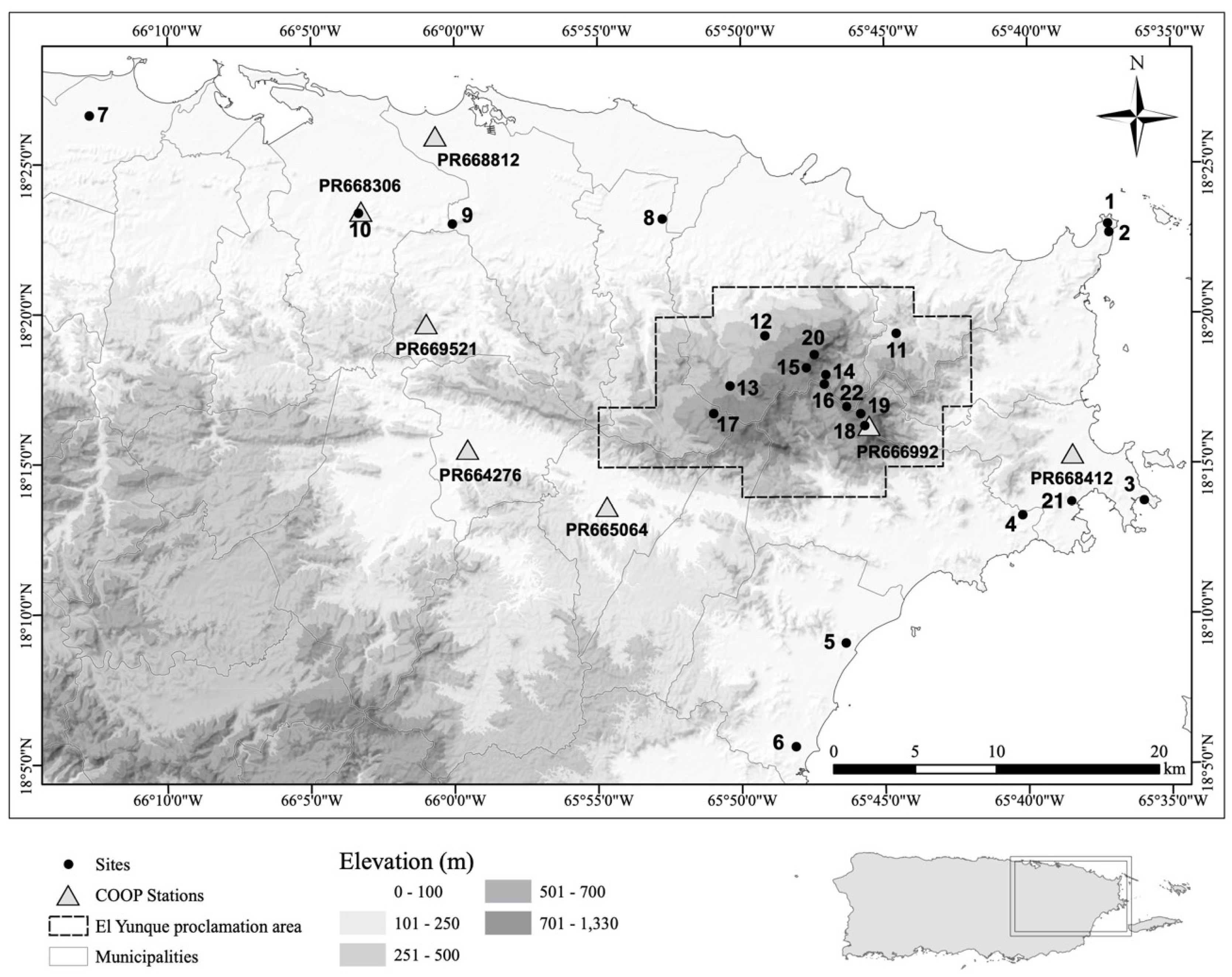
Disclaimer/Publisher’s Note: The statements, opinions and data contained in all publications are solely those of the individual author(s) and contributor(s) and not of MDPI and/or the editor(s). MDPI and/or the editor(s) disclaim responsibility for any injury to people or property resulting from any ideas, methods, instructions or products referred to in the content. |
© 2023 by the authors. Licensee MDPI, Basel, Switzerland. This article is an open access article distributed under the terms and conditions of the Creative Commons Attribution (CC BY) license (https://creativecommons.org/licenses/by/4.0/).
Share and Cite
Van Beusekom, A.E.; González, G.; Rivera, M.M. Tropical Forest Microclimatic Changes: Hurricane, Drought, and 15–20 Year Climate Trend Effects on Elevational Gradient Temperature and Moisture. Forests 2023, 14, 325. https://doi.org/10.3390/f14020325
Van Beusekom AE, González G, Rivera MM. Tropical Forest Microclimatic Changes: Hurricane, Drought, and 15–20 Year Climate Trend Effects on Elevational Gradient Temperature and Moisture. Forests. 2023; 14(2):325. https://doi.org/10.3390/f14020325
Chicago/Turabian StyleVan Beusekom, Ashley E., Grizelle González, and María M. Rivera. 2023. "Tropical Forest Microclimatic Changes: Hurricane, Drought, and 15–20 Year Climate Trend Effects on Elevational Gradient Temperature and Moisture" Forests 14, no. 2: 325. https://doi.org/10.3390/f14020325
APA StyleVan Beusekom, A. E., González, G., & Rivera, M. M. (2023). Tropical Forest Microclimatic Changes: Hurricane, Drought, and 15–20 Year Climate Trend Effects on Elevational Gradient Temperature and Moisture. Forests, 14(2), 325. https://doi.org/10.3390/f14020325







